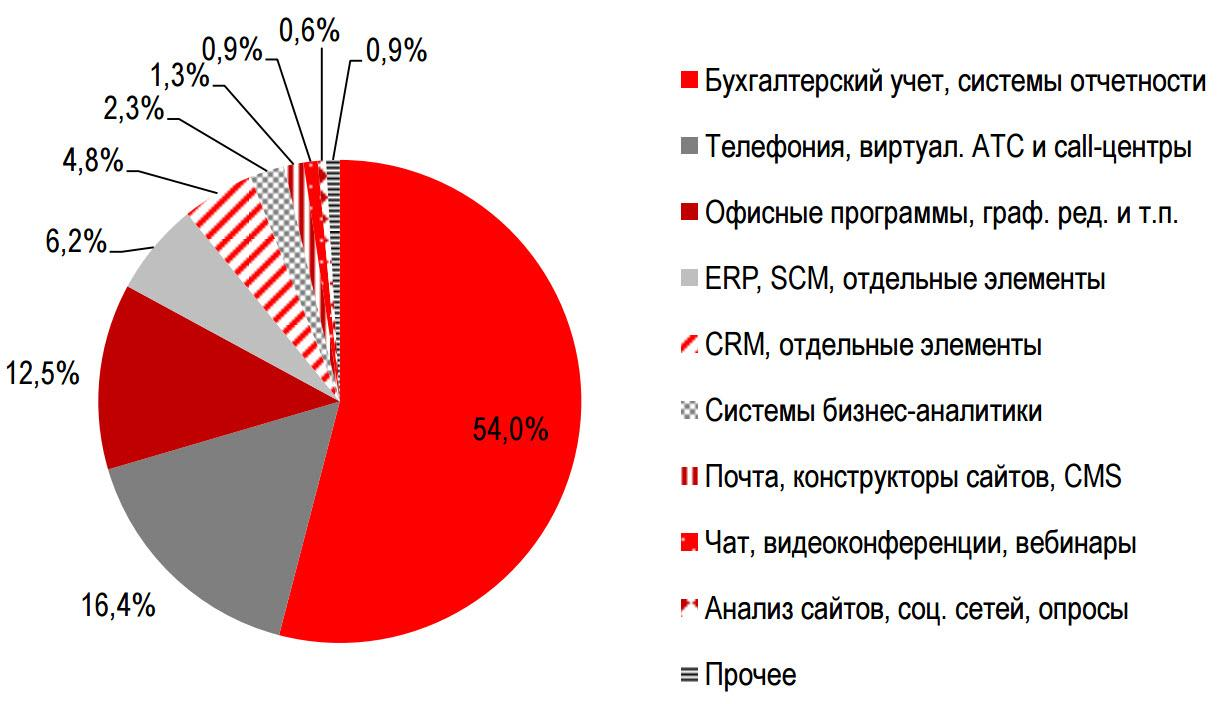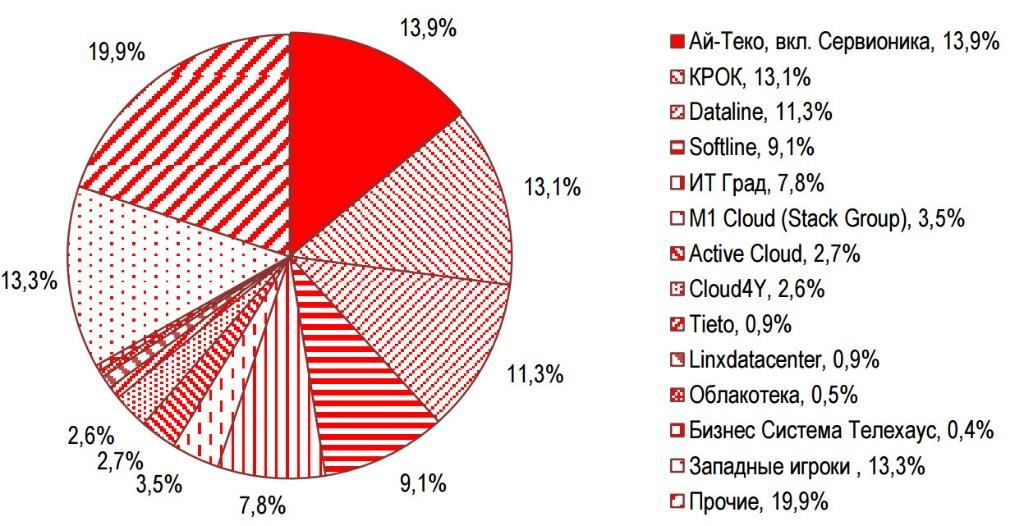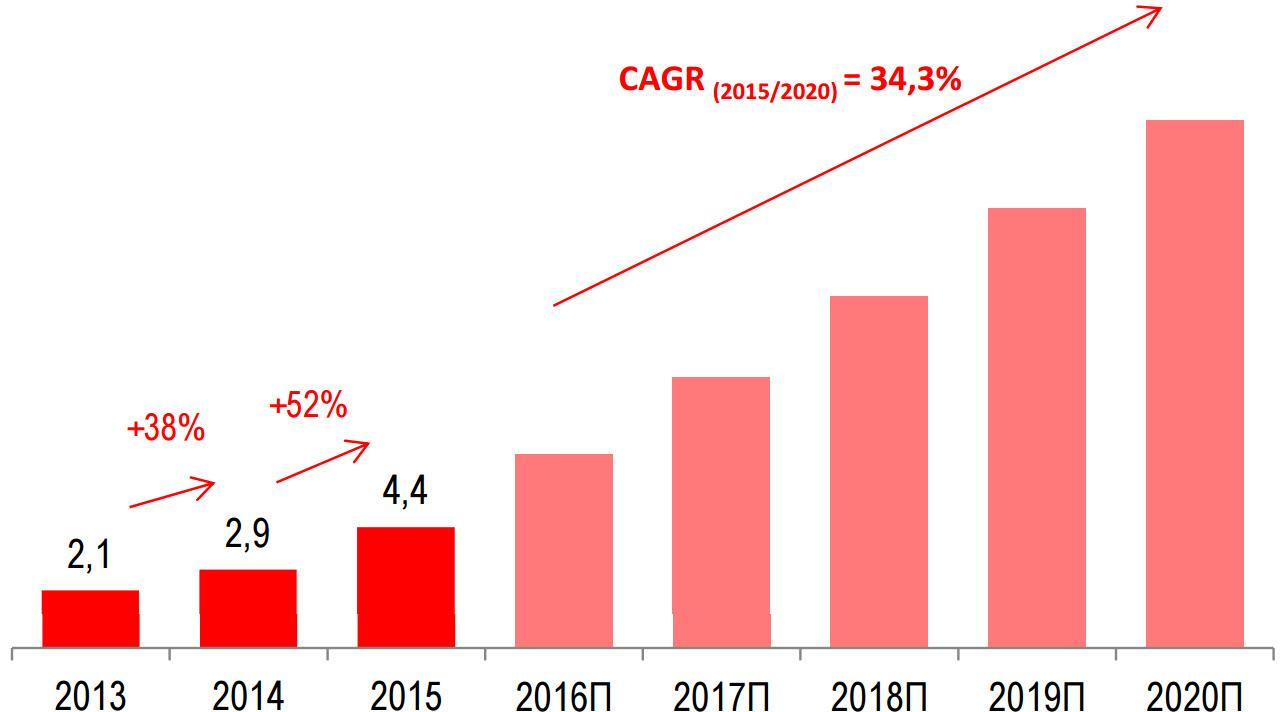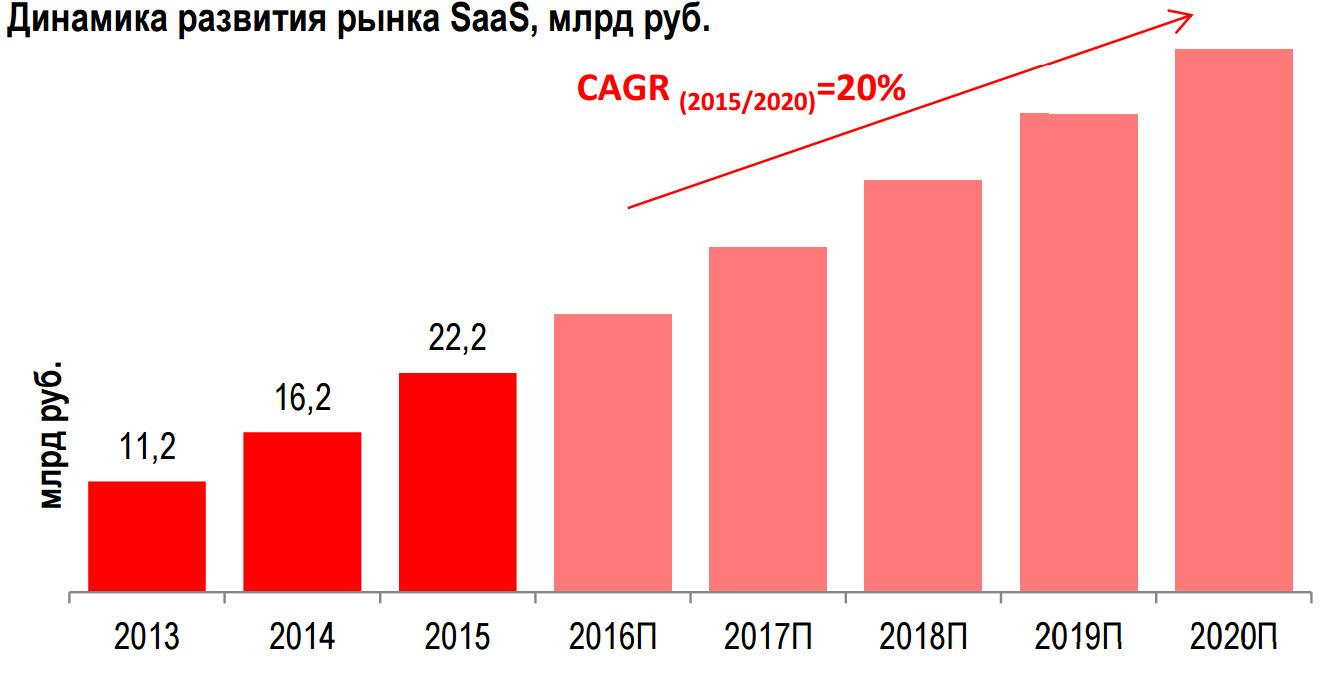What to expect from the cloud market in the next five years?
Clouds unnoticed have become an important part of modern IT. A few years ago, cloud platforms were a curiosity, which was interesting to touch, but trying to implement yourself is difficult and expensive. And this was true even for large organizations.

About the possibility of a simple creation of hybrid or private clouds, even speech was not. What's the secret? Let's figure it out.
Now we can say that the situation has changed a lot. Not to be unfounded, we give a few figures from the study IKS Consulting. In 2013, the volume of IaaS-services amounted to 2.1 billion rubles. The figure, in principle, is already rather big. If you do not compare it with the data at the end of 2015 - 4.4 billion. In just two years, the market has more than doubled. The role of SaaS services has increased in the same way - from 11.2 billion to 22.2 billion.

')
Immediately clarify. It may seem that these figures reflect only the situation on the market of public cloud services, leaving behind private and hybrid solutions, but this is not entirely true. Certain error, of course, will be present, but on the whole the situation is reflected correctly, and here is why.
Corporate clouds are still extremely niche. In most cases, companies simply do not need to create a complex cluster infrastructure of several machines. It is much easier and cheaper to either deploy a regular local server, or use a public one.
A private cloud is needed to solve highly specialized tasks, for example, from the banking sector. Obviously, servers serving Internet banking or CRM with customer data should not be moved outside the bank itself. But to implement a project management system or organize remote jobs for employees of the PR department can be in the public cloud.
Hybrid solutions are also largely reflected in the figures presented. They are used when the capacity of a separate server is no longer enough, but creating a full-fledged private cloud is still too expensive and does not pay for itself.
Here is one of the real situations from our practice: the store began to experience difficulties with processing orders during the New Year holidays. It was impossible to put up with the situation: the calls were gone, the customers were leaving. Increasing power is not profitable: additional expensive equipment would stand idle for 11 months a year. The exit is a hybrid cloud. But in this case, it is still necessary to rent the missing capacity from one of the providers, therefore, these costs are already taken into account in the figures presented above.
Cloud services are represented mainly by SaaS and IaaS solutions. There are, of course, PaaS services, but they occupy a very small amount (about 0.3 billion rubles in total), so we will not consider them in this review. Let's see what place each of the services in the market.
Let's start with SaaS. The study of IKS Consulting showed that the following types of leased software are in greatest demand:
Share other services can be seen in the chart. All of them are quite niche, and therefore do not occupy a large percentage of the market.

It’s not easy to segment IaaS solutions, because the offered services cannot be clearly demarcated. It is unlikely that someone will buy separately only a server operating system without the server itself. Therefore, representatives of these cloud technologies are trying to provide services as comprehensively as possible.
IKS Consulting divided the IaaS market by the revenue share of the largest players. You can see the resulting picture in the figure, but we will understand the trends that it reflects.

The IaaS market will continue to grow. According to IKS Consulting, its volume will increase by 34.3% annually. However, already from this figure it is clear that the pace will gradually decrease. If from 2013 to 2015, the increase was more than 100%, then in the period 2016-2018, experts predict figures in the region of 70-80%.

The slowdown is associated with the transition of small and medium businesses to the use of SaaS-solutions. Their use is cheaper than renting a full-fledged cloud infrastructure and allows you to solve problems point-by-point, expanding the range of services as needed. However, large businesses will continue to use IaaS, mainly to create hybrid clouds: in the long run, creating your own network on rental servers with all the necessary software will be more profitable than the monthly fee for each individual product.
SaaS-market also predict growth, but smoother - only + 20% annually. This is largely due to the fact that one of the industries - accounting - has already reached a peak and its share is more than half of all revenues.

The strongest growth should be expected from CRM and ERP. Now these systems occupy a small market share, but at the same time they are extremely in demand in business - the total revenue from the integration of programs for managing customer bases in 2015 amounted to more than 5 billion rubles. It is noticeable that this figure is significantly higher than the volume of cloud services CRM and ERP combined. There is room to grow.
If we talk about the cloud market as a whole, then big business can have a big impact on its growth. Now representatives of this sector are extremely cautious about public networks. For example, according to Terrasoft, cloud-based CRM systems use only 20% of large corporations, while 90% of small businesses last year switched to the use of rental software.
However, in order to attract large business to cloud technologies, in our opinion, several problems need to be solved:
If these problems are successfully resolved in the next 2-3 years, then we will be able to come in 2020 with a much larger volume of the cloud technology market than many studies predict.
And what do you personally think about the future of the clouds?

About the possibility of a simple creation of hybrid or private clouds, even speech was not. What's the secret? Let's figure it out.
How much?
Now we can say that the situation has changed a lot. Not to be unfounded, we give a few figures from the study IKS Consulting. In 2013, the volume of IaaS-services amounted to 2.1 billion rubles. The figure, in principle, is already rather big. If you do not compare it with the data at the end of 2015 - 4.4 billion. In just two years, the market has more than doubled. The role of SaaS services has increased in the same way - from 11.2 billion to 22.2 billion.

')
Immediately clarify. It may seem that these figures reflect only the situation on the market of public cloud services, leaving behind private and hybrid solutions, but this is not entirely true. Certain error, of course, will be present, but on the whole the situation is reflected correctly, and here is why.
Corporate clouds are still extremely niche. In most cases, companies simply do not need to create a complex cluster infrastructure of several machines. It is much easier and cheaper to either deploy a regular local server, or use a public one.
A private cloud is needed to solve highly specialized tasks, for example, from the banking sector. Obviously, servers serving Internet banking or CRM with customer data should not be moved outside the bank itself. But to implement a project management system or organize remote jobs for employees of the PR department can be in the public cloud.
Hybrid solutions are also largely reflected in the figures presented. They are used when the capacity of a separate server is no longer enough, but creating a full-fledged private cloud is still too expensive and does not pay for itself.
Here is one of the real situations from our practice: the store began to experience difficulties with processing orders during the New Year holidays. It was impossible to put up with the situation: the calls were gone, the customers were leaving. Increasing power is not profitable: additional expensive equipment would stand idle for 11 months a year. The exit is a hybrid cloud. But in this case, it is still necessary to rent the missing capacity from one of the providers, therefore, these costs are already taken into account in the figures presented above.
The structure of modern clouds
Cloud services are represented mainly by SaaS and IaaS solutions. There are, of course, PaaS services, but they occupy a very small amount (about 0.3 billion rubles in total), so we will not consider them in this review. Let's see what place each of the services in the market.
SaaS: clouds for accountants
Let's start with SaaS. The study of IKS Consulting showed that the following types of leased software are in greatest demand:
- Accounting software - 54%. There is nothing unexpected. Maintaining financial statements is a prerequisite for the existence of any official organization. Mostly cloud-based accounting is preferred by small and medium-sized enterprises, for which data confidentiality is not so critical. This segment of the business now, despite the crisis, continues to grow (over 600 thousand new enterprises in 2015, according to the Federal Tax Service). So, the sphere of accounting cloud services will only grow. However, the presence of sufficiently large competition in the industry will only lead to an increase in the market volume, while the growth of new players will be insignificant.
- Telephony and virtual PBX - 16.4%. This sphere occupies a smaller volume primarily because of the greater number of alternatives. If, in the case of accounting, the obvious choice is between “using special software” and “doing all calculations manually”, then communication can be done in many different ways: via local telephone lines, e-mail, and instant messengers. On the other hand, the number of cloud services for telephony clients is bigger. For this area, privacy issues are not so relevant, on the contrary, the ability to record and store conversations is welcome. Therefore, it is also preferred by large organizations to carry telephone communications into the clouds, having a significant impact on the growth of the segment. Small and medium businesses prefer to use cloud PBX due to the complexity and high cost of self-realization of this technology on their own equipment.
- Office programs - 12.5%. Despite the fact that text and graphic editors are used everywhere, their cloud versions occupy a small market share. This is largely due to the fact that the additional capabilities of such software (mobility, simultaneous work with a file for several people) are required by a small number of employees. The rest of the usual versions of the programs.
- ERP systems - 6.2%. It is quite expected that most enterprises are afraid to put programs for analyzing business processes in the cloud, preferring box solutions. Mostly these services are rented by small or start-up companies that still cannot afford to pay for a license and deploy their cloud.
- CRM systems - 4.8%. As in the case of accounting, management of the client database is necessary for any, even the smallest organization. And if the reluctance of large players to transfer their infrastructure to the cloud is still understandable, then such a low popularity of such services among small and medium-sized businesses is surprising. Perhaps in the near future we can expect a more rapid growth in this direction of SaaS.
Share other services can be seen in the chart. All of them are quite niche, and therefore do not occupy a large percentage of the market.

IaaS: native data centers
It’s not easy to segment IaaS solutions, because the offered services cannot be clearly demarcated. It is unlikely that someone will buy separately only a server operating system without the server itself. Therefore, representatives of these cloud technologies are trying to provide services as comprehensively as possible.
IKS Consulting divided the IaaS market by the revenue share of the largest players. You can see the resulting picture in the figure, but we will understand the trends that it reflects.

- The leading place is occupied by system integrators. This means that cloud technologies are most often not implemented by a separate service, but are included in larger-scale sets of services. For example, a hybrid cloud can be deployed in an organization in order to use it to integrate a security system that includes many other solutions: video surveillance, antivirus software, information leakage measures, etc.
- Customers prefer IaaS services using their own equipment. Three leaders in revenue provides services solely on the basis of its own data centers. And this is due not only to the fact that thanks to their data centers, companies can offer better prices than resellers. An important role is played by the physical location of servers in the territory of the Russian Federation, which is very important for Russian enterprises.
- In addition to IaaS services, customers are interested in additional benefits. Other companies, following the top three, mainly use equipment in partner data centers. However, the provision of educational and consulting services allows them to occupy leading positions. In addition to the organization of cloud structures, these enterprises are engaged in conducting trainings, master classes, teach the use of clouds in business, etc.
Cloud market by 2020
The IaaS market will continue to grow. According to IKS Consulting, its volume will increase by 34.3% annually. However, already from this figure it is clear that the pace will gradually decrease. If from 2013 to 2015, the increase was more than 100%, then in the period 2016-2018, experts predict figures in the region of 70-80%.

The slowdown is associated with the transition of small and medium businesses to the use of SaaS-solutions. Their use is cheaper than renting a full-fledged cloud infrastructure and allows you to solve problems point-by-point, expanding the range of services as needed. However, large businesses will continue to use IaaS, mainly to create hybrid clouds: in the long run, creating your own network on rental servers with all the necessary software will be more profitable than the monthly fee for each individual product.
SaaS-market also predict growth, but smoother - only + 20% annually. This is largely due to the fact that one of the industries - accounting - has already reached a peak and its share is more than half of all revenues.

The strongest growth should be expected from CRM and ERP. Now these systems occupy a small market share, but at the same time they are extremely in demand in business - the total revenue from the integration of programs for managing customer bases in 2015 amounted to more than 5 billion rubles. It is noticeable that this figure is significantly higher than the volume of cloud services CRM and ERP combined. There is room to grow.
If we talk about the cloud market as a whole, then big business can have a big impact on its growth. Now representatives of this sector are extremely cautious about public networks. For example, according to Terrasoft, cloud-based CRM systems use only 20% of large corporations, while 90% of small businesses last year switched to the use of rental software.
However, in order to attract large business to cloud technologies, in our opinion, several problems need to be solved:
- Convincingly prove to potential customers the safety of technology. Already, the clouds are sufficiently secure and reliable to accept data from large companies. It remains only to convey this idea to the clients themselves.
- Provide the ability to implement SaaS services as a hybrid cloud. Most companies that offer rental programs, work in public mode. Large organizations prefer to store all key information on their servers. However, not all SaaS solutions can be run on local machines or can at least take data from them, without the need to upload information directly to the cloud. This scares potential customers.
- Implement a complex of services "turnkey". Now the majority of manufacturers working on the “Soft as a service” model are concentrated on only one kind of activity. Big business needs a lot of solutions, which are individually expensive and inconvenient to acquire. If a company gets the opportunity to purchase both accounting and virtual PBX and a CRM system from one supplier, this will save such an organization from having to implement all this functionality in a hybrid cloud and use IaaS.
If these problems are successfully resolved in the next 2-3 years, then we will be able to come in 2020 with a much larger volume of the cloud technology market than many studies predict.
And what do you personally think about the future of the clouds?
Source: https://habr.com/ru/post/316570/
All Articles